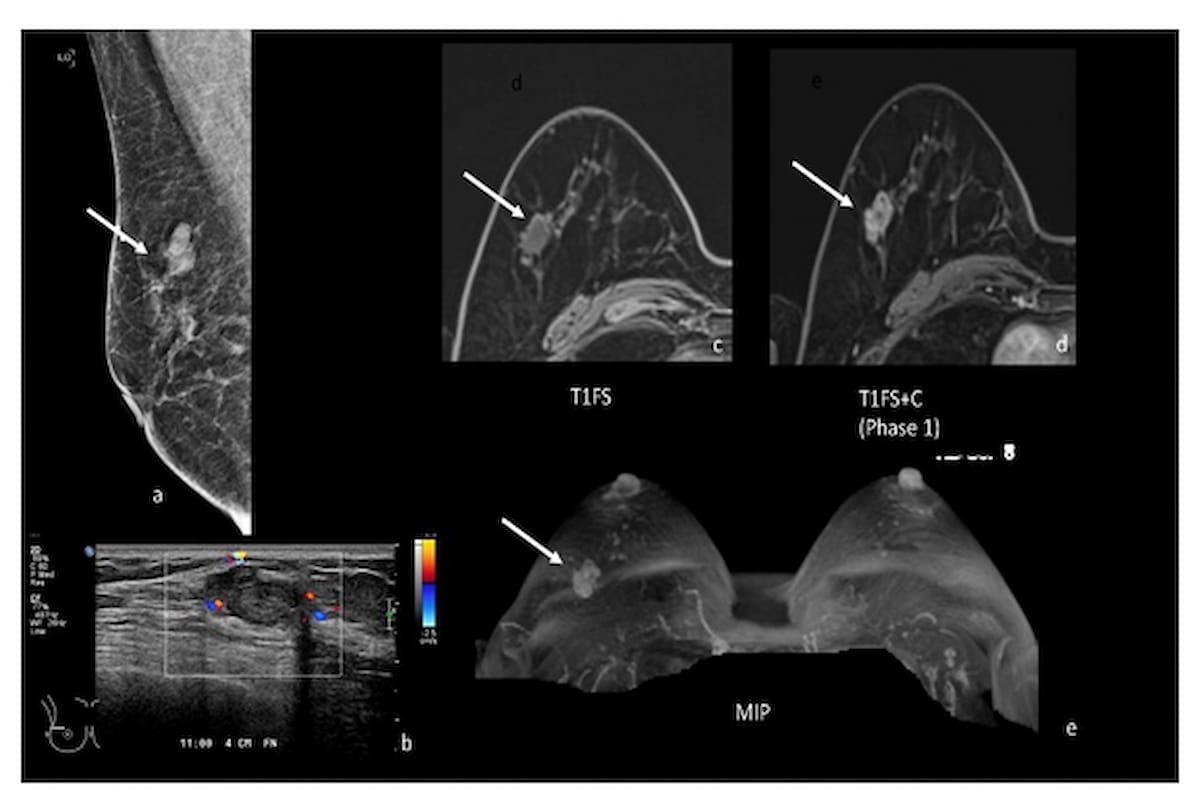Emerging research suggests that digital breast tomosynthesis (DBT) and abbreviated breast MRI (AB-MR) have similar effectiveness in diagnosing breast cancer in women with dense breasts, and that AB-MR may provide more utility in reducing false positive results.
For the retrospective study, recently published in Clinical Radiology, researchers examined DBT and AB-MR data from 115 women (mean age of 50.6) with ACR BI-RADS breast density C (79.1 percent) and D (20.9 percent). Out of 164 histopathology-proven breast lesions, the researchers noted that 57.9 percent were benign, and 42.1 percent were malignant.
The study authors found that DBT and AB-MR had similarly high sensitivity rates (98.5 percent for both) and negative predictive values (NPVs) of 94.7 percent and 96.2 percent respectively.
Abbreviated MRI also demonstrated a slightly higher specificity rate (43.9 percent vs. 34.6 percent) and positive predictive value (PPV) (67.2 percent vs. 66.3 percent) in comparison to DBT.
“These findings suggest that AB-MR may be more accurate in distinguishing true negative results, potentially reducing false positive rates and unnecessary biopsies,” wrote lead study author Marlina Tanty Ramli Hamid, MBChB, MRad, who is affiliated with the Department of Radiology at the University Teknologi MARA in Selangor, Malaysia, and colleagues.
Acknowledging the low specificity rates of DBT (34.6 percent) and AB-MR (43.9 percent), the study authors suggested that a high proportion of BI-RADS 4 lesions in both cohorts (32.9 percent for DBT and 26.2 percent for AB-MR) was a factor with this finding. The researchers also pointed out similar positive predictive value (PPV) for BI-RADS 4 lesions in the DBT (38.9 percent) and AB-MR cohorts (39.5 percent).
Three Key Takeaways
- Similar effectiveness in diagnosing breast cancer. The study suggests that digital breast tomosynthesis (DBT) and abbreviated breast MRI (AB-MR) exhibit comparable effectiveness in diagnosing breast cancer in women with dense breasts. Both imaging methods demonstrated high sensitivity rates (98.5%) and similar negative predictive values (NPVs).
- Reduced false positives with AB-MR. Abbreviated breast MRI (AB-MR) may offer more utility in reducing false positive results compared to DBT. The study indicates that AB-MR demonstrated a slightly higher specificity rate (43.9% vs. 34.6%) and positive predictive value (PPV) (67.2% vs. 66.3%) than DBT, potentially leading to more accurate differentiation of true negative results.
- Considerations for lesion classification. The study highlights that both DBT and AB-MR showed relatively low specificity rates, with a significant proportion of BI-RADS 4 lesions in both cohorts. The authors suggest that the presence of BI-RADS 4 lesions, which are often found to be benign upon further evaluation, contributed to the low specificity rates. Additionally, there was a slightly higher PPV for DBT in patients with BI-RADS 5 lesions, possibly attributed to the nature of certain benign breast lesions that may be misclassified as BI-RADS 5 on MRI.
“This demonstrates that a relatively high percentage of BI-RADS 4 lesions detected by both imaging methods are ultimately found to be benign upon further evaluation,” noted Hamid and colleagues.
The researchers also pointed a slightly higher PPV for DBT in comparison to AB-MR in patients with BI-RADS 5 lesions (94 percent vs. 91.1 percent).
“This finding could be attributed to the presence of benign breast lesions with vascular or inflammatory nature, such as PASH (pseudoangiomatous stromal hyperplasia), mastopathy and mastitis, which may exhibit rapid initial enhancement and be misclassified as BI-RADS 5 on MRI,” added Hamid and colleagues.
(Editor’s note: For related content, see “Study Says Contrast-Enhanced Mammography Offers Comparable Breast Cancer Detection to MRI,” “Can DWI MRI Offer a Viable Non-Contrast Alternative for Breast Cancer Assessment” and “Large Mammography Study Reaffirms Benefits of Digital Breast Tomosynthesis.”)
Beyond the inherent limitations of a retrospective, single center study, the authors said the findings may have limited extrapolation to a broader population as the cohort was primarily comprised of Malaysian and Chinese women. Hamid and colleagues also noted that their center primarily utilizes MRI for diagnostic purposes, which may have led to potential bias and a higher number of breast cancer detection cases than what may be expected in a typical practice setting.

